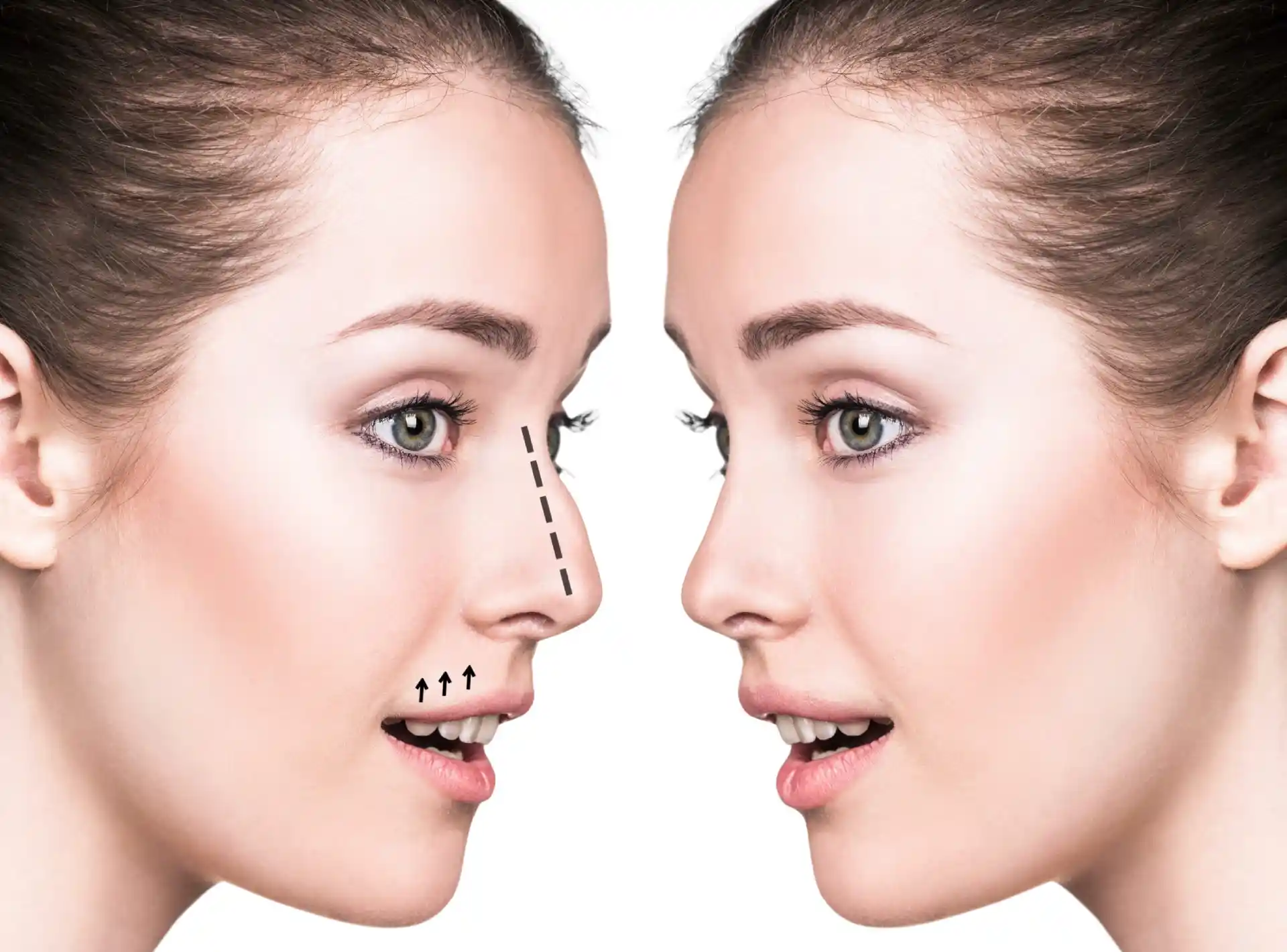What Is Rhinoplasty?
Rhinoplasty, also known as a nose job, is a procedure that changes the functioning or appearance of the nose. There are numerous reasons why you should consider rhinoplasty, including changing the shape, size, and proportions of the nose and treating medical issues such as breathing difficulties, congenital disabilities, or trauma defects.
But, regardless of the reason, it is critical to understand the procedure and its value before deciding to undergo surgery. This article will teach you about the procedure, its benefits, recovery time, and other factors so you can make the best decision for your nose job.
Rhinoplasty In Dubai
Rhinoplasty in Dubai is a highly sought-after cosmetic surgery in which skilled plastic surgeons reshape and refine the nose for both aesthetic and functional reasons. Rhinoplasty provides permanent and natural-looking results that are tailored to each patient’s facial features, whether it’s correcting a hump, adjusting the tip, narrowing the nostrils, or improving breathing. Cutting-edge tools and advanced surgical techniques are used to ensure patient safety, accuracy, and optimal results.
Rhinoplasty Procedure?
Rhinoplasty, or nose plastic surgery, is done under general anesthesia or local anesthesia with sedation. When it comes to surgically altering or improving the appearance of the nose, there are two techniques: open and closed. Both techniques are unique, provide distinct benefits, and cannot be compared for better results.
While the open technique has an external incision on the columella, the close technique does not have an external incision on the outside of the nose because incisions are hidden inside the patient’s nose and modifications are performed from within the nostrils. C&N (Close Rhinoplasty & Natural Look) has additional advantages, including:
- No skin lifting.
- No scar.
- Shorter surgical time.
- More natural appearance.
- Faster recovery.
- Less trauma.
- Excellent experience with both primary and revision cases.
Though the close technique appears to be more advantageous for some nasal modifications, your surgeon is best suited to determine whether an open or closed technique will provide the best treatment results. This is how a nose lift or reshaping is performed. In addition to cosmetic surgery, we restore nose function by correcting nasal septum deviation and reducing turbinate size to improve nasal airway and breathing.
BOOK AN APPOINTMENT TODAY
Recovery After The Rhinoplasty Procedure
You can return home the same day as the procedure, but at least one week off work is required to allow for healing. You should rest properly and apply ice to the nose. No forceful blowing of the nose is permitted, and it should be thoroughly cleaned daily. Swelling may occur for the first 4-5 days but gradually subsides thereafter. Pain medications are administered to alleviate discomfort, but they are typically only required for the first few days.
Within a week, the discomfort, pain, and swelling have subsided, and the cast and splints can be removed. You can join work and participate in all daily activities, including workouts. However, any contact sport must be avoided for at least six weeks to prevent nose injury. Complete recovery from surgery may take 7 to 13 months.
Benefits Of Rhinoplasty
Rhinoplasty produces long-lasting results, with gradual changes in the appearance and function of the nose over the course of a year, culminating in permanent results. Here are the advantages of rhinoplasty that can alter the way you look or breathe.
- Improved breathing.
- Clefts, masses, lumps, underdevelopment, and other congenital disabilities have all been corrected.
- Restored facial symmetry.
- Increase self-confidence.
MEET THE EXPERT DOCTOR
Who Needs Rhinoplasty?
Rhinoplasty is recommended for medical reasons when all other conservative treatments fail to provide relief. A common medical reason for surgery is difficulty breathing through the nose due to a nasal obstruction. In terms of cosmetics, rhinoplasty can produce exceptional results and shape your nose for a more attractive facial appearance.
Another factor to consider when deciding whether to undergo surgery is the cost of rhinoplasty. The cost varies by hospital and may be determined by the extent of surgery required as well as your facial appearance. Though you should consider all of these factors when deciding on nose surgery, finding the best rhinoplasty surgeon is just as important for achieving the desired results.
The rhinoplasty surgeons at Perfect Doctors Clinic are well-versed in all modern techniques and have the necessary experience to fix your nasal problems and give you a fresh new appearance.
How Can I Speed Up Healing After Rhinoplasty?
During the first few weeks after rhinoplasty surgery, you should do everything you can to make sure your nose heals properly.
Because your surgeon told you to, you should take over-the-counter painkillers if you are feeling pain.
- Cool compresses (not ice) should be put under your eyes or on your cheeks, but not on your nose itself.
- Stay away from things that could hit you in the face.
- You should be careful not to put too much pressure on the bridge of your nose when you wear glasses or sunglasses.
- Make sure your head is up, especially when you’re sleeping.
- Cut down on the time you spend outside in the sun.
- Do not blow your nose.
- Do not lift anything that is too heavy.
- Because your surgeon told you to, you should take over-the-counter painkillers if you are feeling pain.
What Are The Stages Of Swelling After Rhinoplasty?
You will have swelling right away after rhinoplasty surgery. When your nose is bigger than usual, it’s called swelling. This happens because fluid builds up inside and under your skin. After rhinoplasty surgery, the following stages of swelling may happen:
- Four to six weeks after surgery: After surgery, your nose will be swollen for four to six weeks. It will make it look and feel bigger than usual. While it heals, the skin around your nose may get bruises or change color.
- Three months after surgery: Between one and three months, the swelling will slowly go down. About 90% of the swelling will be gone after three months.
- One year after surgery: Even up to a year after surgery, your nose may still have some small swelling. When the swelling goes away, you’ll be able to see the full results of the surgery.
After rhinoplasty surgery, everyone heals in their own way. It’s possible that the swelling will be different and that you will see results at different times. Make sure you keep all of your follow-up appointments and do what your doctor tells you to do after surgery to make sure your nose heals properly.
What Are The Different Surgical Approaches To Rhinoplasty?
Rhinoplasty can be broken down into two main types:
- Open: An open rhinoplasty is a major nose reshaping surgery. After making cuts, your surgeon will be able to see clearly through your nose because the skin will be completely separated from the bone and cartilage.
- Closed: Closed rhinoplasty is a small surgery that changes the shape of the nose. Your doctor will make cuts inside your nose to separate the skin from the bone and cartilage so that they can change the shape of it.
Some other types of rhinoplasty are:
- Cosmetic rhinoplasty makes your nose and face look better.
- Cosmetic rhinoplasty that doesn’t involve surgery is called “filler rhinoplasty.” Dermal fillers are used to temporarily cover up bumps and dips in your nose. It can fix a small bump or lift the tip of your nose that is drooping.
- Functional rhinoplasty: Brings back the shape and function of the nose after illness, cancer treatment, or serious injuries. This kind of reconstructive surgery can also fix birth defects and a septum that isn’t straight.
- If problems happen after the first rhinoplasty surgery, a secondary rhinoplasty can fix them. Occasionally these issues are small, but usually they are more difficult for your surgeon to fix.
When Can I Go Back To My Regular Activities After Rhinoplasty Surgery?
When it comes to resuming your regular activities or returning to work, you should heed the advice of your physician if you have undergone rhinoplasty surgery. After a break of two to three weeks, you should be able to return to school or work. Again, you will be able to perform light exercises within a time frame of five to seven weeks. For a period of five to seven weeks, avoid lifting anything that is heavy.
When Will I See The Results Of Rhinoplasty?
When your splint comes off about a week after rhinoplasty surgery, you should see a difference in how your nose looks. Your nose may not fully settle into its new shape for up to a year. It is normal for the face to swell up a bit during this time. After having functional rhinoplasty to fix a deviated septum, most people feel better in seven weeks. About 20% of people who have had surgery need a follow-up surgery to make small changes to what was done the first time.
How Long Does Rhinoplasty Last?
Rhinoplasty is a permanent way to change the shape of your nose. People will always remember the results. You might need a second rhinoplasty surgery to make any changes to your appearance look the way you want them to after you’re fully healed.
Best Plastic Surgeon In Dubai For Rhinoplasty
Best Plastic Surgeon in Dubai for Rhinoplasty is available at Perfect Doctors Clinic. This procedure combines skill and new technology to give patients both better nasal function and improved appearance. A nose job is another name for rhinoplasty. It is a surgery that changes the shape or size of the nose. A rhinoplasty is more than just a cosmetic procedure. It resolves problems with how the nose works as well as its shape and appearance. It can fix a deviated septum, improve airflow, and help people who have trouble breathing.
















































